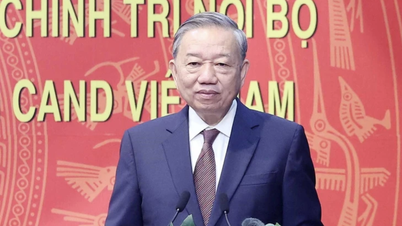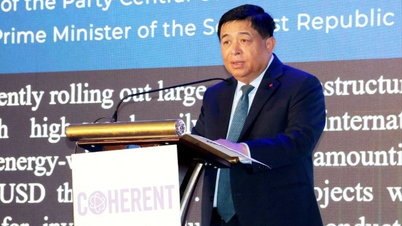Deposit interest rates decrease, loan interest rates have not kept up
According to new decisions issued on June 16 by the State Bank of Vietnam, the maximum interest rate applied to deposits with terms from 1 month to less than 6 months has decreased from 5%/year to 4.75%/year, while the maximum interest rate for deposits in VND at People's Credit Funds and Microfinance Institutions has decreased from 5.5%/year to 5.25%/year. The interest rate for deposits with terms of 6 months or more is determined by credit institutions based on the supply and demand of capital in the market. In addition, the overnight lending interest rate in interbank electronic payments and lending to cover capital shortages in the State Bank's clearing payments to credit institutions has decreased from 5.5%/year to 5%/year; the refinancing interest rate has decreased from 5%/year to 4.5%/year; the rediscount interest rate has decreased from 3.5%/year to 3%/year.

The ceiling interest rate for mobilizing savings in VND under 6 months has dropped to 4.75%/year since June 19.
The maximum short-term lending interest rate in VND of credit institutions to meet capital needs for a number of economic sectors and industries is reduced from 4.5%/year to 4%/year; the maximum short-term lending interest rate in VND of People's Credit Funds and Microfinance Institutions for these capital needs is reduced from 5.5%/year to 5%/year.
The new interest rate will be officially applied on June 19. This is the fourth time the State Bank has reduced the operating interest rate. On June 16, the interest rate on the interbank market decreased by 0.04 - 0.36%/year for all terms compared to the previous day. The overnight interest rate is 1.01%/year, 1 week is 1.37%/year, 2 weeks is 1.86%/year, 1 month is 3.21%/year, 3 months is 4.94%/year, 9 months is 6.75%/year, and 1 year is 7.18%/year. Thus, compared to 1 week ago, the transaction interest rates of banks decreased from 0.2 - 1.66%/year and compared to the highest level in the past 1 year, the interest rates decreased from 1.88 - 7.34%/year for all terms.
Although interbank interest rates have fallen sharply, the interest rates for mobilizing VND from banks to individual customers remain high. For terms under 6 months, the ceiling interest rate for mobilizing VND from June 19 has decreased by 1.25%/year, down to 4.75%/year. Some banks have interest rates lower than the new ceiling, including 4 major banks Vietcombank, Vietinbank, BIDV and Agribank at 4.1 - 4.6%/year for terms under 6 months. From 6 months and above, the interest rate is from 5.5 - 6.8%/year. However, other commercial banks have interest rates for mobilizing VND under 6 months from 4.5 - 5%/year; 6-month term from 6 - 7.8%/year; 12-month term from 6.7 - 8.1%/year...
How to get interest rates down?
Meanwhile, lending interest rates have not fallen as fast as deposit interest rates. For customers borrowing to buy houses, cars, etc., bank interest rates range from 12 to 15% per year. Businesses borrow at common interest rates of 9 to 10% per year.
Dr. Le Dat Chi - Head of the Finance Department of Ho Chi Minh City University of Economics does not expect much from the State Bank of Vietnam this time to reduce the operating interest rate to quickly reduce the loan interest rate in the market. Like the previous 3 times, banks will cite the reason for not being able to reduce the loan interest rate immediately, from the delay of the policy to the limited credit limit, potential bad debt... The mechanism of managing the credit limit for each bank that has existed for many years has distorted the credit market, this is also one of the reasons why the loan interest rate is difficult to reduce.
Interest rates on the interbank market and the open market (where the State Bank pumps and withdraws money from the market) have decreased, but the mobilization interest rates in the residential sector remain high, showing that the capital markets are not very connected to each other. Mr. Nguyen Huu Huan - Head of the Finance Department of Ho Chi Minh City University of Economics said that some banks have high capital needs to solve internal problems such as credit limits, corporate bonds, etc. And if only a few banks need capital, pushing up mobilization interest rates, other banks will find it difficult to reduce mobilization interest rates quickly. Not to mention that banks are worried that adjusting mobilization interest rates down will lose capital, so they still secretly negotiate interest rates higher than the announced level. "If mobilization interest rates are high, how can lending be reduced? If we want lending interest rates to go down, regulators need to strictly handle the "collusion" in interest rates, and at the same time support banks that are currently facing problems such as credit limits, corporate bonds, etc.", Mr. Huan emphasized.
In order for the above policy to continue to be effective, reduce delays, and create conditions for interest rate reduction, BIDV Training and Research Institute makes the following recommendations: It is necessary to improve the effectiveness of policy coordination, especially between monetary policy, fiscal policy, price policy and other macro policies to proactively control inflation and stabilize the macro economy. Accelerate the restructuring of weak credit institutions and low liquidity to minimize unhealthy competition in increasing interest rates, sometimes breaking the general interest rate level, making interest rate reduction more difficult. At the same time, promptly remove obstacles in administrative procedures, legality, capital, etc. in areas such as land, real estate, construction, bidding, customs clearance, access to electricity, fire prevention and fighting, registration, etc. These are synchronous solutions to help businesses and people reduce difficulties and challenges and also stimulate investment, consumption and credit in the coming time. Credit institutions and enterprises themselves continue to promote restructuring, reduce costs, and strengthen risk management (especially market risks, financial risks, legal risks, etc.) thereby creating conditions for a more widespread and sustainable reduction in interest rates.
Source link

























![[Photo] National Assembly Chairman attends the seminar "Building and operating an international financial center and recommendations for Vietnam"](https://vphoto.vietnam.vn/thumb/1200x675/vietnam/resource/IMAGE/2025/7/28/76393436936e457db31ec84433289f72)










































































Comment (0)